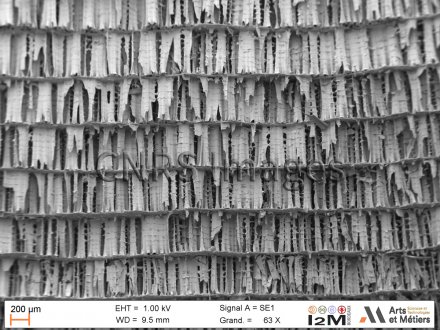Production year
2022

© Louise LE BARBENCHON / I2M / CNRS Images
20220122_0001
Looking atthe living world, its shapes, materials and structures, can inspire the materials of tomorrow. Take this cuttlefish bone, whose unique features are revealed under the microscope. Its microstructure, arranged in layers, columns and undulations, gives it remarkable properties, such as a high degree of rigidity despite very low density – with porosity of around 93%. Rather than suddenly breaking when struck, cuttlefish bone, which is made up of the calcium carbonate mineral aragonite, is instead able to absorb a large amount of mechanical energy. This damage tolerance could prove very useful in the design of future bio-inspired materials, such as ceramic foams, for the protection of people and property. This image was taken using scanning electron microscopy. It is one of the winners of the 2022 La preuve par l’image (LPPI) photography competition.
The use of media visible on the CNRS Images Platform can be granted on request. Any reproduction or representation is forbidden without prior authorization from CNRS Images (except for resources under Creative Commons license).
No modification of an image may be made without the prior consent of CNRS Images.
No use of an image for advertising purposes or distribution to a third party may be made without the prior agreement of CNRS Images.
For more information, please consult our general conditions
2022
Our work is guided by the way scientists question the world around them and we translate their research into images to help people to understand the world better and to awaken their curiosity and wonderment.